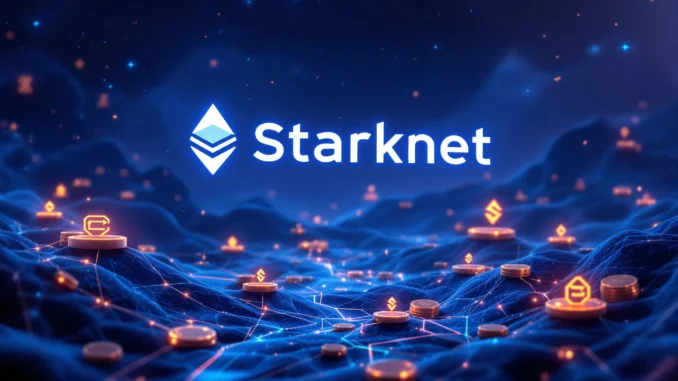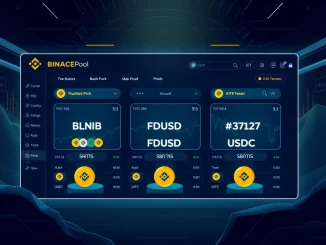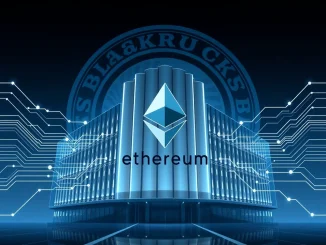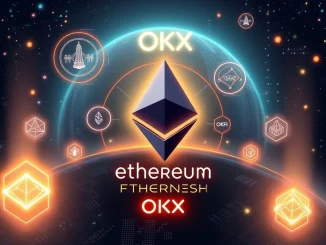
Get ready, crypto enthusiasts! Starknet, the innovative Ethereum layer-2 scaling solution leveraging zk-rollup technology, has just dropped some thrilling news. Starknet (STRK) is gearing up to launch Phase 2 of its highly anticipated STRK staking program in Q2 2025. This announcement, made via their official X account, signals a significant step forward in the network’s decentralization and governance. But what does this mean for you, and what can you expect from this next phase of STRK staking? Let’s dive into the details and uncover everything you need to know about Starknet’s exciting roadmap.
What’s New in Starknet STRK Staking Phase 2?
Phase 2 of Starknet staking isn’t just another update; it’s a crucial stepping stone towards the network’s fully realized vision. The cornerstone of this phase is the introduction of validator block attestation. But what exactly does this mean? Think of it as a performance review for potential validators. Before validators are formally entrusted with the critical role of consensus participation in Phase 3 (slated for Q4 2025), Phase 2 will serve as a testing ground.
Key Highlights of Starknet STRK Staking Phase 2:
- Validator Block Attestation: This is the central feature of Phase 2. It’s designed to rigorously assess the performance and reliability of validators.
- Performance Evaluation: The attestation process will allow Starknet to gather vital data on how validators operate under real-world conditions. This data is crucial for ensuring the network’s robustness and security.
- Preparation for Consensus: Phase 2 is explicitly designed as a preparatory stage for Phase 3, where validators will take on their full consensus responsibilities.
- Q2 2025 Launch: Mark your calendars! Starknet is targeting Q2 2025 for the launch of this pivotal phase.
Why is Validator Performance Assessment Important for Starknet?
In any blockchain network, especially a layer-2 scaling solution like Starknet, the performance of validators is paramount. Validators are the backbone of the network, responsible for crucial tasks such as block validation and ensuring network security. Validator performance directly impacts several key aspects of Starknet:
- Network Security: High-performing validators contribute to a more secure and resilient network, making it harder for malicious actors to compromise the system.
- Transaction Speed and Efficiency: Efficient validators ensure faster transaction processing and lower latency, leading to a smoother user experience on Starknet.
- Network Stability: Reliable validators contribute to the overall stability and uptime of the Starknet network, reducing the risk of disruptions.
- Decentralization: A healthy and diverse set of high-performing validators strengthens the decentralization of Starknet, making it more resistant to censorship and single points of failure.
By implementing validator block attestation in Phase 2, Starknet is proactively ensuring that only the most capable and reliable validators will participate in the consensus process in Phase 3. This cautious and methodical approach underscores Starknet’s commitment to building a robust and dependable Ethereum layer-2 solution.
The Road to Full Consensus: Phase 3 and Beyond
While Phase 2 focuses on validator assessment, Phase 3 is where validators will officially step into their roles in consensus. Scheduled for Q4 2025, Phase 3 will mark a significant milestone for Starknet, bringing it closer to its vision of a fully decentralized and permissionless network.
Looking Ahead to Phase 3:
- Formal Validator Roles: Validators will transition from performance assessment to active participation in Starknet’s consensus mechanism.
- Consensus Participation: Validators will be responsible for block production, validation, and finalization, ensuring the integrity and security of the Starknet blockchain.
- Increased Decentralization: Phase 3 will further decentralize Starknet by distributing network control among a wider range of validators.
- Continued Evolution: Starknet’s roadmap doesn’t end with Phase 3. The network is committed to continuous improvement and innovation, with future phases likely to introduce even more advanced features and functionalities.
What Role Does Crypto Governance Play in STRK Staking?
Decentralization isn’t just about technology; it’s also about governance. Starknet understands this deeply, and that’s why crypto governance is a crucial aspect of their staking roadmap. The announcement explicitly mentions an upcoming governance vote for STRK holders. This is a powerful signal that Starknet is committed to involving its community in shaping the future of the network.
Governance Vote for STRK Holders:
- Community Involvement: The governance vote empowers STRK holders to directly participate in key decisions related to the staking program and the network’s development.
- Decentralized Decision-Making: By putting important decisions to a community vote, Starknet reinforces its commitment to decentralized governance.
- Transparency and Inclusivity: Governance votes promote transparency and inclusivity, ensuring that the community’s voice is heard and considered in the network’s evolution.
- Shaping the Future: The outcomes of governance votes can have a significant impact on the direction of Starknet, making it essential for STRK holders to participate actively.
While the specifics of the governance vote are yet to be revealed, it’s clear that Starknet values the input of its community. This vote will likely cover important parameters related to STRK staking, potentially including aspects of validator selection, rewards distribution, and other key elements of the staking program.
Unlocking the Potential of Ethereum Layer-2 Staking with Starknet
Starknet’s approach to Ethereum layer-2 staking is methodical and forward-thinking. By breaking down the staking rollout into phases, Starknet is prioritizing network stability and security while gradually empowering its community. Phase 2 is a vital intermediary step, ensuring that when validators take on their full roles in Phase 3, they are well-prepared and rigorously tested.
Benefits of Starknet’s Phased Staking Approach:
- Reduced Risk: Phased rollout minimizes risks associated with launching a complex staking program by allowing for thorough testing and refinement at each stage.
- Enhanced Security: Validator performance assessment in Phase 2 directly contributes to a more secure and robust network in Phase 3.
- Community Empowerment: Governance votes give STRK holders a voice in shaping the staking program and the network’s future.
- Sustainable Growth: A well-planned and executed staking program is essential for the long-term sustainability and growth of the Starknet ecosystem.
As Starknet progresses towards Phase 2 and then Phase 3, it is solidifying its position as a leading Ethereum layer-2 scaling solution. The focus on robust validator performance, coupled with decentralized governance, paints a promising picture for the future of STRK staking and the Starknet network as a whole.
Looking Forward: What’s Next for STRK Holders?
For STRK holders, the announcement of Phase 2 is undoubtedly exciting. Here’s what you can anticipate in the coming months:
- Stay Tuned for Governance Vote Details: Keep an eye on Starknet’s official channels for announcements regarding the upcoming governance vote. Your participation is crucial!
- Research Validator Requirements: If you are interested in becoming a Starknet validator in the future, start researching the requirements and preparations needed.
- Monitor Phase 2 Progress: Follow Starknet’s updates on the rollout of Phase 2 to stay informed about the network’s development.
- Prepare for Potential Staking Opportunities: While Phase 2 is about validator assessment, it paves the way for broader staking opportunities in later phases. Keep STRK staking on your radar!
Conclusion: Starknet’s Staking Future is Bright
Starknet’s announcement of STRK staking Phase 2 is more than just a roadmap update; it’s a testament to their commitment to building a secure, decentralized, and community-driven Ethereum layer-2 network. By prioritizing validator performance and empowering STRK holders through governance, Starknet is laying a strong foundation for the future of STRK staking and the entire ecosystem. As we eagerly await Q2 2025, the Starknet community has much to look forward to. The journey to full consensus and beyond is underway, and the future of Starknet looks incredibly bright.



